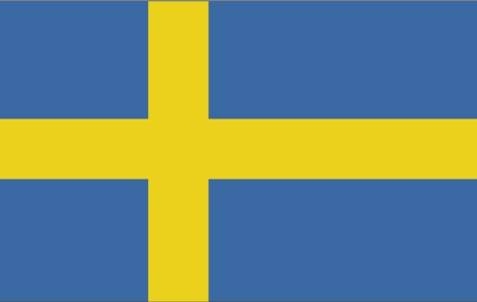111 Sweden

Blue with a golden yellow cross extending to the edges of the flag. The vertical part of the cross is shifted to the hoist side in the style of the Dannebrog (Danish flag). The colors reflect those of the Swedish coat of arms – three gold crowns on a blue field.
Flag courtesy of the CIA World Factbook

Map courtesy of the CIA World Factbook

Ice hotel (2005).
Photo courtesy of the CIA World Factbook
Government
According to Britannica, Sweden is a constitutional monarchy. The constitution, dating from 1809 and revised in 1975, is based on the following four fundamental laws: the Instrument of Government, the Act of Succession, the Freedom of the Press Act, and the Riksdag (Parliament) Act. All the laws have been subject to amendment. The constitution is based on the principles of popular sovereignty, representative democracy, and parliamentarism.
The reigning monarch is the head of state but exerts no political power; the responsibilities of the monarch are ceremonial only. Succession is accorded to the firstborn child regardless of sex. The prime minister is nominated by the speaker of the Riksdag after consultations with party leaders and must be approved for office through a vote of the Riksdag. The prime minister appoints the other cabinet members. The cabinet is responsible for all government decisions.
The ministries are small, and they are not concerned with details of administration or implementation of legislation. This is handled by central administrative agencies, whose senior officials are appointed by the cabinet.
In the preparation of important measures to be considered by the government, the responsible minister normally calls upon a commission of inquiry to appraise the measure. The commission may often include politicians from opposition parties, representatives of labour, and scientists and civil servants. They produce a printed report that is sent to various agencies and organizations for official comments before it is presented as background material to government legislation.
The Riksdag, a unicameral parliament elected by the people for four-year terms, is the foundation for the democratic exercise of power through the cabinet. The Riksdag appoints its speaker, deputy speakers, and standing committees, in which parties are represented in proportion to their strength. All bills are referred to committees; the results of their deliberations are reported in printed form to the Riksdag in plenary session.
The Riksdag may call for a consultative (nonbinding) referendum on various issues; decisive (binding) referenda may be held on amendments to the constitution if demanded by one-third of the Riksdag.
Local government is allocated to the kommuner (municipalities), each with an elected assembly and the right to levy income taxes and to charge fees for various services. Municipalities have a strong independent position. Streets, sewerage, water supply, schools, public assistance, child welfare, housing, and care for elderly people are among their responsibilities. Elections coincide with parliamentary elections.
Between the national and municipal government is a regional tier of 21 län (counties) headed by a county governor, appointed by the national government. Each county also has an elected council that has the right to levy income tax and that administers health care, certain educational and vocational training, and regional transport.
The National Law Code of 1734 is still in force, although almost none of its original text remains. In modern times, moreover, a mass of special legislation has grown outside the code to cover new needs. Roman law has had less influence in Sweden than in most European countries. Since the end of the 19th century, much civil law has been prepared in collaboration with the other Nordic countries.
Primary responsibility for the enforcement of law devolves upon the courts and the administrative authorities. Sweden has a three-tiered hierarchy of courts: the district courts (tingsrätter), the intermediate courts of appeal (hovrätter), and the Supreme Court (högsta domstolen). District courts play the dominant role. A peculiar feature of these courts is a panel of lay assessors (nämndemän), who take part in the main hearings, primarily on more serious criminal and family cases. In such cases, the bench consists of a legally trained judge as chairman and three lay assessors. These panels are not to be confused with an Anglo-American or continental type of jury.
In the six courts of appeal (the oldest one established in 1614), cases are decided by three or four judges. Appeals against their decisions can be carried to the Supreme Court only if the case is deemed important to the interpretation of law. In the Supreme Court the bench consists of five justices (justitieråd).
Legal aid is provided for anyone who wants it. The general penalties for convictions are fines and imprisonment. Fines are set in proportion to the person’s daily income. Offenders under 18 years of age are sentenced to prison only in exceptional cases.
The decisions of administrative authorities, which cannot be appealed to an ordinary court of justice, can be appealed to higher administrative authorities and ultimately to the government or to administrative courts, such as county administrative courts (länsrätter) in matters of taxation. Higher administrative courts of appeal are called kammarrätter. The highest administrative tribunal is the Supreme Administrative Court (regeringsrätten), which tries cases involving such issues as taxation, insanity, alcoholism, and juvenile delinquency.
The Labor Court (Arbetsdomstolen) is a special body that deals with controversies in the interpretation and application of collective bargaining agreements. Of its seven members, two represent labour and two represent management.
The Office of the Parliamentary Ombudsman (Justitieombudsman) is an original Swedish institution, established in 1809; it has become a model for similar offices in other countries. The ombudsman’s chief duty is to see that the courts and civil service enforce the laws properly, especially those laws that safeguard the freedom, security, and property of citizens. They have the power to institute prosecutions in court and, in particular, to act against officials who abuse their powers or act illegally. Other ombudsmen are not appointed by the Riksdag but have similar duties of surveillance in other areas. Thus, there are an antitrust ombudsman, a consumer ombudsman, an equal-opportunities ombudsman, and an ethnic-discrimination ombudsman.
The chancellor of justice (justitiekansler) is a government appointee who supervises courts and administrative organs with particular concern for safeguarding the state’s interests.
Swedish Transport Agency
The Swedish Transport Agency is working to achieve good accessibility, high quality, secure and environmentally aware rail, air, sea and road transport. We have overall responsibility for drawing up regulations and ensuring that authorities, companies, organizations and citizens abide by them. The Swedish Transport Agency was established on the 1st of January 2009.
Airspace
SkyVector – Google Maps – ADS-B Exchange
ICAO countries publish an Aeronautical Information Publication (AIP). This document is divided into three parts: General (GEN), En Route (ENR) and Aerodromes (AD). ENR 1.4 details the types of airspace classes they chose to adopt from classes A through G.
Drone Regulations
Advanced Air Mobility (AAM) Regulations & Policies
Bilateral agreements facilitate the reciprocal airworthiness certification of civil aeronautical products imported/exported between two signatory countries. A Bilateral Airworthiness Agreement (BAA) or Bilateral Aviation Safety Agreement (BASA) with Implementation Procedures for Airworthiness (IPA) provides for airworthiness technical cooperation between the FAA and its counterpart civil aviation authorities.
Reciprocal acceptance of aviation safety-related approvals and services with the European Union Aviation Safety Agency (EASA) and Member States of the European Union are primarily governed by the U.S. – European Union Safety Agreement.
Note: The European Union has designated that import, export, and oversight of certain ‘low risk’ civil aviation products are not covered by the EU, and will be administered by individual EU Member State aviation authorities. These products are defined in Annex 1 of REGULATION (EU) 2018/1139 (formerly known as “Annex 2 aircraft”). FAA validation/U.S. import of these products will be governed by the BASA IPA between the FAA and that EU Member State aviation authority, not the US-EU Safety Agreement.
Legacy Implementation Procedures for Airworthiness (IPA): Contact AIR-40 at 9-AWA-AVS-AIR400@faa.gov for assistance when using this legacy IPA in support of a project, and before contacting an Authority about use and effectivity of this document.
Advanced Air Mobility (AAM) News
2025 – Sweden to deploy Frequentis UTM system
2025
Video courtesy of Advanced Air Mobility Institute from the July 2025 Global AAM Forum.
2025
Video courtesy of Advanced Air Mobility Institute from the January 2025 Global AAM Forum. Complete session for Day 1 of this Forum is available on the Advanced Air Mobility Institute YouTube Channel
2024 – Electric Aircraft Initiative for Swedish Island
2024 – Unifly’s UTM Platform Advances Urban Air Mobility in Europe
2023 – STILFOLD aims to revolutionize urban air mobility with ‘origami’ vertiports
2023 – ZeroAvia strikes deal to bring zero-emission flights to Sweden
2022 – Sweden to fly Linköping-to-Norrköping drone missions in October as precursor to UAM/AAM
Short Essay Questions
Scenario-Based Question
You have been hired by a Drone Startup Company. Your boss has immediately assigned this job to you.
They need you to prepare a one-page memo detailing the legalities of using a drone to film the ice hotel, pictured above.
They need you to mention any national laws and local ordinances.
They specifically want to know what airspace (insert pictures) you will be operating in and whether or not you need an airspace authorization.
Does it matter whether or not you are a citizen of the country?
Lastly, there is a bonus for you if, as you scroll through this chapter, you find any typos or broken links!
Short Essay Questions
- What are the drone categories?
- How is registration addressed?
- How is remote ID addressed?
- What are the model aircraft rules?
- What are the commercial drone rules?
- Are there waivers or exemptions to the rules? If so, for what?
- Would you share a link to an interactive airspace map?
- How is BVLOS addressed?
- How can you fly drones at night?
- How can you fly drones over people?
- Where do you find drone NOTAMs?
- What are the rules for drone maintenance?
- What are the rules for an SMS program?
- What are some unique rules not mentioned above?
- What are the C-UAS rules?
- What are the AAM rules?

